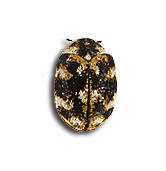General Characteristics:
- Diet includes animal and plant substances, powdered milk, dog and cat food, leather, book bindings, dead insects, bird and rodent nests, cotton, linen, and rayon
- The larvae live in void areas and furniture
- Feeding often occurs under heavy furniture or at carpet edges
- Adult beetles fly frequently in May and June and may enter structure due to their attraction to light
How to distinguish between various species:
VARIED CARPET BEETLE
(Anthrenus verbasci)
- Adult length is about 1/10 to 1/8 inch
- Body is round in shape and grey in colour
- A pattern of white, yellow and brown scales are present on elytra (wing covers)
- Larvae are about ¼ inch long and light to dark brown in colour
BLACK CARPET BEETLE
(Attagenus unicolor)
- Body is oval and shiny-black with brownish legs
- Adult length ranges from 1/8 to 3/16 inch
- Larvae are golden to dark brown and about ½ inch long
COMMON CARPET BEETLE
(Anthrenus scrophulariae)
- Adult body is nearly round and gray to black in colour
- Adult length rangse from 1/10 to 1/8 inch
- Small whitish scales and a band of orange-reddish scales are present down the middle of the back and around the eyes
- Larvae are elongated, oval, reddish-brown, about ¼ inch long and possess brownish-black hairs
FURNITURE CARPET BEETLE
(Anthrenus flavipes)
- Adult length ranges from 1/16 to 1/8 inch
- Body is round and white in colour, with black spots outlined with yellowish orange
- Larvae are about ¼ inch long, elongated, oval and covered with thick brown hairs
Reproduction:
- All species undergo egg, larva, pupa and adult stages
- Depending on the species, each female can lay up to 100 white eggs or more
- Eggs hatch in 8 to 15 days in warm weather
- Larvae feed destructively and molt several times as they develop
- 60 days to a year or more may be spent in the larval stage
- Adults emerge from their pupae in the Spring
- Most species have 3 to 4 generations per year except for the black or varied carpet beetles that may only have 1 generation per year
Signs of Infestation:
- Adult beetles flying near windows may assist in locating infestation
- Cast skins from the larvae and can also help locate problem areas
- Carpet beetle larvae prefer to feed in dark, undisturbed, protected places
- A thorough inspection should be conducted before treatment
Control Techniques:
- Proper sanitation is critical for prevention
- Regular vacuuming, disposing of old animal hides and clothing, storing furs in cold rooms and removing old bird and rodent nests can all aide in preventing infestations
- Insecticides may be used for existing infestations ACCORDING TO LABEL SPECIFICATIONS AND IN ACCORDANCE WITH FEDERAL, PROVINCIAL AND MUNICIPAL LAWS
- A professional should be contacted for identification and treatment of this species
Please click here to contact a Focus Pest Control professional to inquire about further treatments for this pest species.
References:
Benett, Gary W., et.al.. Truman’s Scientific Guide to Pest Control Operations. Duluth: Advanstar Communications, 1988. p. 270-273.
“Ohio State University Extension Fact Sheet (Entomology) - Carpet Beetle” (On-line). Ohio State University Entomology. Accessed Jan. 7, 2010 at http://ohioline.osu.edu/hyg-fact/2000/2103.html.
Disclaimer:
The Focus Pest Control ‘Pest Library’ is an educational resource written largely to educate the general public about common pests in Ontario. The Focus ‘Pest Library’ does not include all species in Ontario, nor does it include the most recent scientific data about species we describe. Though we edit our accounts for accuracy, we cannot guarantee all information in those accounts. While Focus Pest Control staff and contributors provide references to books and websites that we believe are reputable, we cannot necessarily endorse the contents of references beyond our control.
(Back to top)
|

 Varied Carpet Beetle
Varied Carpet Beetle